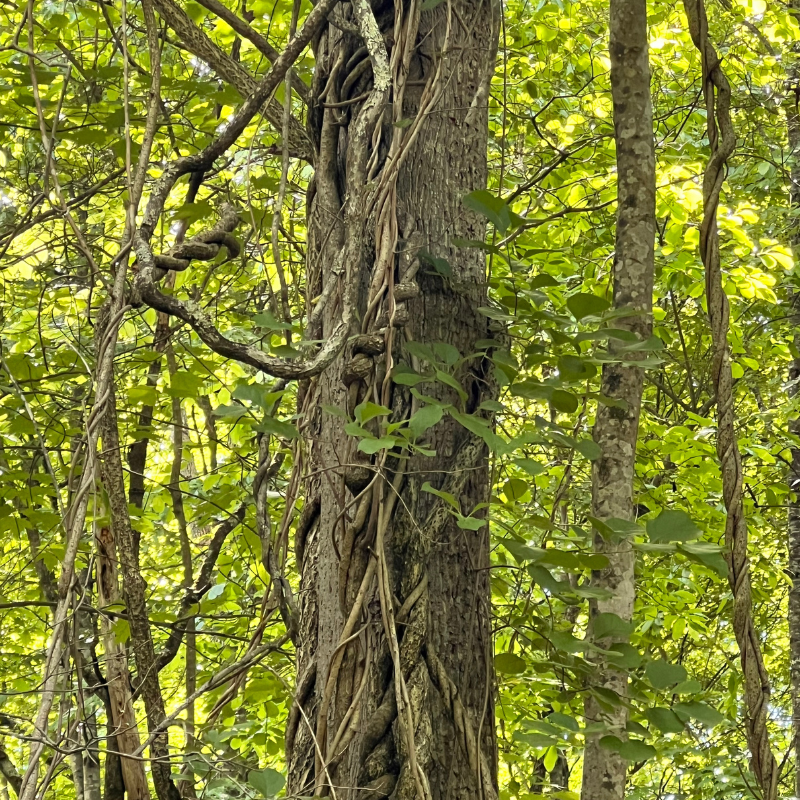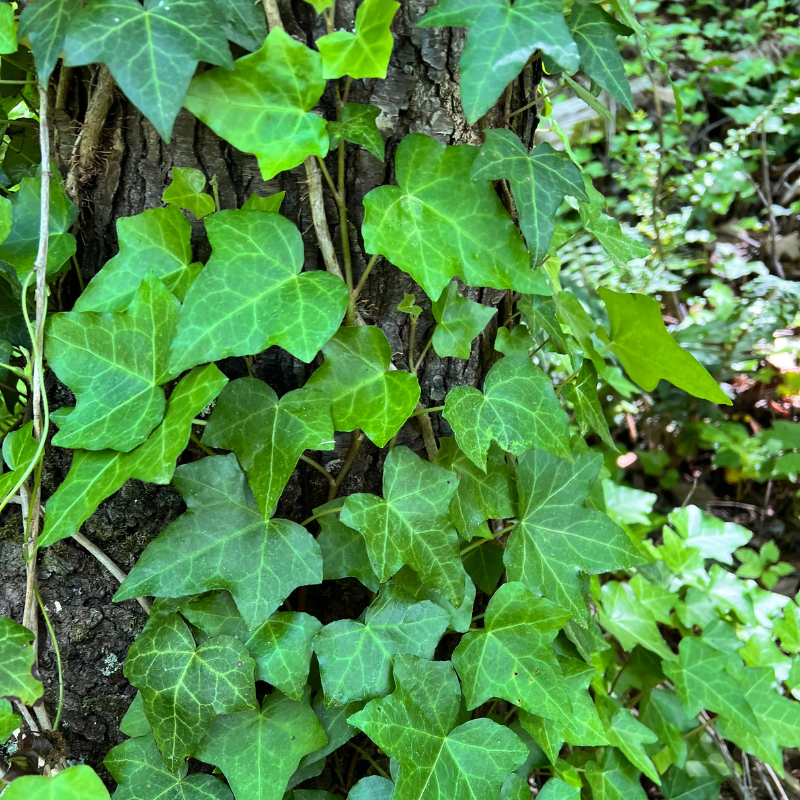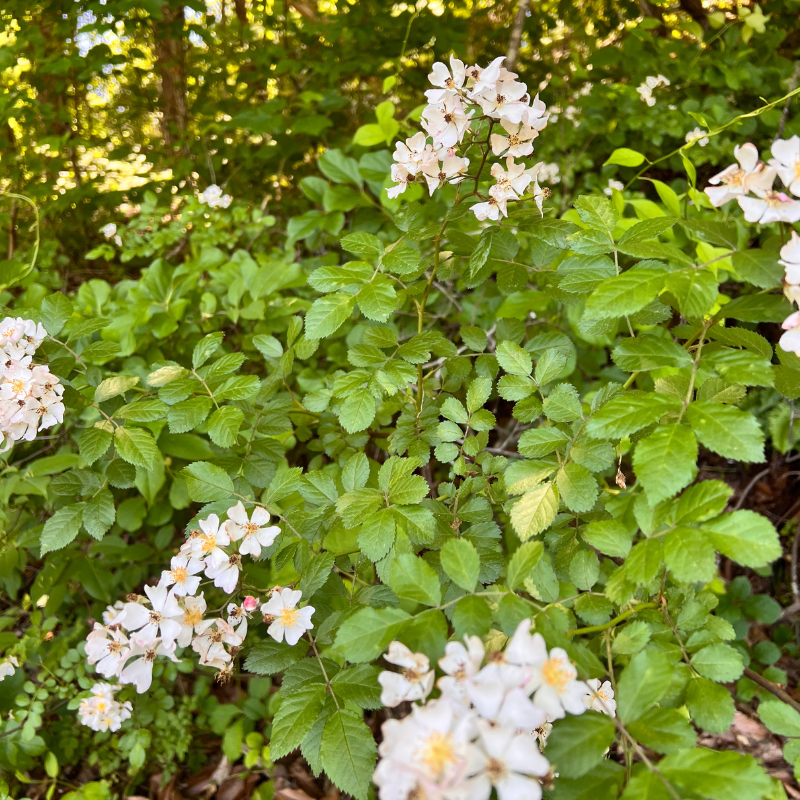7 minute read
Written by Stella Nelson
Invasive species are an inevitable part of owning and managing land — especially when you’re working to steward that land with long-term ecological health in mind. At Durrant Farms Estate, we take a holistic, agroforestry-based approach to conservation. Our goal is not just to maintain the land, but to actively restore and enhance its biodiversity, creating a resilient forest ecosystem that supports both native wildlife and future generations.
Agroforestry blends the principles of agriculture and forest management to create a balanced, sustainable relationship between people, plants, and the land. That includes cultivating native species, restoring soil health, improving carbon storage, and maintaining the integrity of our 80-acre woodland. However, one of the greatest threats to this vision is the persistent spread of invasive plant species. These aggressive, non-native plants can quickly undo years of restoration work by outcompeting the native species that are critical to a functioning, diverse ecosystem.
On our land, three invasives in particular make regular appearances: Oriental Bittersweet, English Ivy, and Multiflora Rose. Each one brings its own challenges to our conservation work — and each one demands an informed and strategic response.
Oriental Bittersweet (Celastrus orbiculatus) is easily one of the most challenging invasive species we deal with here in Western North Carolina. It’s a deciduous woody vine with rounded leaves and thick, spotted vines that wrap around and slowly strangle trees. This aggressive grower is extremely common and spreads quickly — both by seed and by root fragments left behind during removal. Any leftover roots can resprout within days, and even small broken pieces of vine are capable of forming their own root systems. It doesn’t respond well to repeated cutting either, since it stores nutrients deep in its roots. Think of it as the Hydra of invasive plants — cut it down, and two more take its place.

The most effective control method, as prescribed by the National Park Service, is to cut the vines back to the ground and immediately treat the cut stems with a paint-on herbicide. At Durrant Farms, one of our core values is minimizing the use of synthetic chemicals in our landscapes. However, when it comes to Oriental Bittersweet, other management techniques have proven largely ineffective. Our goal is to eliminate this invasive from the forest within five years and eventually do away with herbicide use entirely. In the meantime, the paint-on application allows us to target the vine directly and reduce the risk to surrounding native species.
An important consideration with Oriental Bittersweet is that it has a rare native look-alike: American Bittersweet. This native species fills a unique ecological niche and is valuable to local ecosystems. To tell them apart:
- American Bittersweet has fruit only at the tips of its vines, with clusters of 6 or more berries.
- Oriental Bittersweet has smaller clusters of 2–3 berries spaced along the vine.
- The fruit capsules also differ in color — orange for American, yellow for Oriental.
- Finally, their leaf shapes: American Bittersweet has narrower leaves, while Oriental’s are broader.
Correct identification is key to protecting the native species while removing the invader.
English Ivy (Hedera helix) is another invasive we find in various locations across the property, and it’s a familiar sight throughout Western North Carolina. This one is easier to identify — and thankfully, easier to manage. It has dark green, waxy, alternate leaves that are highly variable, usually with 3–5 lobes and prominent veins. English Ivy can simply be pulled up by hand, including from the trees it’s climbing.

When we cleared a heavily infested area on the property, we actually salvaged several vines, potted them, and brought them indoors. It turns out, when contained, this plant makes quite a lovely houseplant. Outside, however, it quickly becomes invasive and can smother native vegetation if left unchecked.
Multiflora Rose (Rosa multiflora) is widespread across the U.S. and shows up frequently here at Durrant Farms. It’s easy to recognize: clusters of 5-petaled white flowers grow on arching stems with plentiful thorns that range in color from bright green to red. Our current approach to management is cutting it back on sight. After repeated cuttings, the plant typically stops returning.

Clearing out Multiflora Rose helps open space for our beautiful native roses — Swamp Rose and Carolina Rose — both of which produce large pink blooms and are well-defended with a dense covering of thorns. These natives are sometimes mistaken for wineberries, another invasive species commonly found in the region.
Through the intentional management of Oriental Bittersweet, English Ivy, and Multiflora Rose, we are steadily reclaiming our forest from these aggressive species. This is more than weed control — it’s a key part of our broader mission to cultivate a resilient, biodiverse landscape through agroforestry and ecological stewardship.
Every vine we cut, every root we pull, and every native plant we reintroduce helps restore the land’s natural balance. These efforts also contribute to broader goals like improving habitat for pollinators and wildlife, strengthening the soil’s ability to retain moisture and nutrients, and fostering a climate-resilient ecosystem that can withstand future environmental pressures.
At Durrant Farms Estate, we believe land management is a long-term relationship. It takes patience, observation, and a deep respect for the interconnected systems at play. While invasive species may always pose a challenge, our commitment to agroforestry ensures that our work is not just reactive, but regenerative — restoring balance to the 80 acres of forest under our stewardship — one vine at a time.